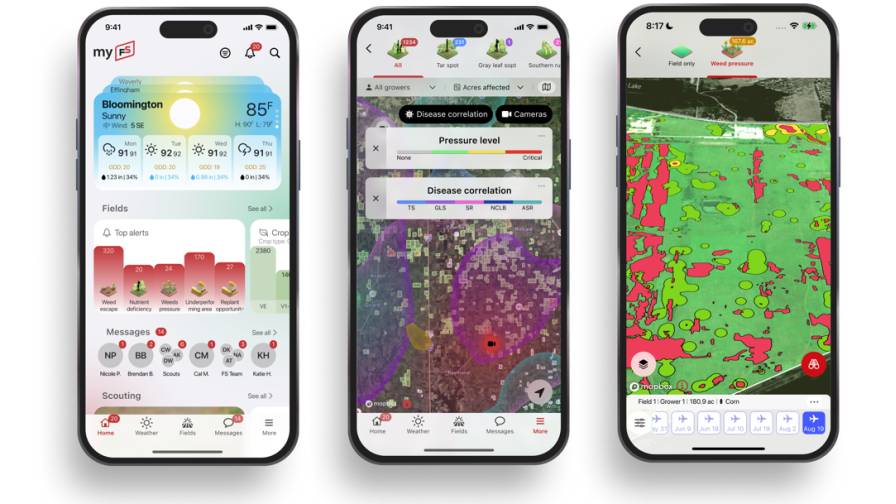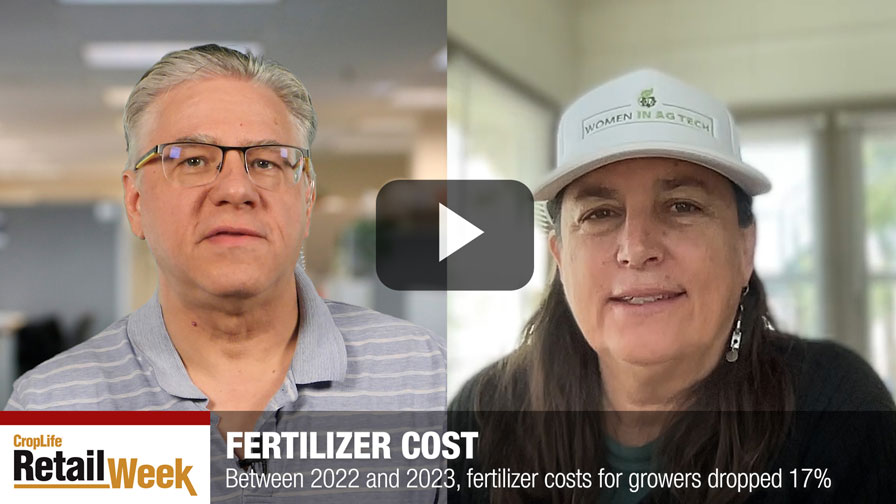A Lesson from ’21: Plan Your Herbicides Early, or Be Out of Luck
If you are a retailer, grower, or custom applicator, chances are you are paying close attention to how well the new(ish) 2,4-D and dicamba technologies are controlling Palmer amaranth and pigweed populations. In a limited number of fields, the answer is, not so well — and naturally, there is a fear of the snowball effect.
To put into perspective how costly the battle has become, farmers surveyed by BASF say they are spending 10X the amount to control pigweed than they were just 10 years ago, according to Kate Greif, Liberty Product Herbicide Manager with BASF.
Greif was part of the initiative BASF launched to take on waterhemp and pigweed in 2019, dubbed Operation Weed Eradication, which is now an industry-wide coalition. That effort is aimed at changing the approach and entire mindset around weed management.
“To me, the keystone, or the top building block is the diligence to control the last weed standing on the farm. That comes back to even one pigweed or Palmer can produce up to a million seeds per plant. That’s the legacy that particular weed is leaving in the field for following season,” Greif says.
“It comes back to residuals,” Dan Beran, Director of Technical Services, Nufarm, tells CropLife®. Beran attended University of Tennessee Extension Weed Specialist Larry Steckel’s field day on June 16, where the two Ts – tank-mixes and timing — were the take-homes for their role in helping control the spread of resistant weeds.
“You can imagine that if your residual package runs out of control at 21 days and it rains for two weeks, your weed size is going to be way too large for any of the available post-emerge herbicides,” Beran says. Tank-mixes with glufosinate (for example, Nufarm’s Cheetah) play a key role, in addition to layering residuals, such as metolachlor and acetochlor over the top. The main message, he says, was don’t spray Xtend or Enlist as a standalone treatment.
“I think with the flexibility that the rise in commodity prices has given it is not necessarily as difficult for a grower to pencil in additional dollars for weed control,” Beran adds. “New traits are very helpful and very welcome but are not bulletproof.”
Rebounding grain prices, says Dane Bowers, Technical Product Lead with Syngenta, offer growers a better position to select more premium herbicides to provide the control that they need preemergence. “I think maybe we saw that this year, and it feels like there was a return to using some of the better products pre to provide that residual activity that we really need. That’s a good sign.”
The weeds didn’t get the memo about high grain prices, however. Larry Steckel shared on his UT blog in late July that he visited cotton fields where Palmer amaranth has escaped an auxin herbicide (Engenia, XtendiMax, Enlist One) application and escaped follow-up glufosinate (Liberty) application. Auxin herbicide-resistant Palmer amaranth was documented in Tennessee last year.
“As such, it was not a surprise to find dicamba or 2,4-D fail to control pigweed. Glufosinate-resistant Palmer amaranth was documented in Arkansas last year. We have not found glufosinate-resistant Palmer amaranth on the Tennessee side of the river,” Steckel wrote. “However, the reports from these fields has us concerned the glufosinate-resistant biotype has indeed crossed the river. Part of the reason for the concern is that we had research fairly close to these suspect fields that showed similar poor Palmer control with dicamba or 2,4-D followed by glufosinate.
“A good approach in those fields now is to get the hoods out and apply paraquat with a residual and remove these escapes ASAP,” Steckel added.
Cases like this are not surprising and continue to drive home the point that growers must use strong residual herbicides preemergence, Bowers advises.
“The idea behind that, of course, is we reduce the number of weeds that are exposed to these postemergence chemistries, and so that reduces odds of finding those rare resistant individuals in any given field,” Bowers tells CropLife. “The (resistant weeds) are there, and while they’re not tremendously common, whenever we let those go to seed, we’re creating future problems and turning those susceptible fields into resistant fields.”
While touring Midwestern fields and research plots by car throughout July, Bowers observed fairly good weed control and, on the whole, better conditions than some previous years have brought — lest we forget the massive rainfall and 20 million prevent plant acres of 2019. Nonetheless, every year is not without its own challenges.
“We had an early spring where we had some really warm temperatures, and growers took advantage of that, then a cold snap set some people back. One of challenges we had with weed control during the spring was a lack of activating rainfall in certain areas, so that created challenges with some of the preemergence herbicides,” he says.
Supply Chain Headaches
Supply chain issues wreaking havoc everywhere, including the agricultural industry, have served as a walk-up call when it comes to the ability to manage weeds, resistant or not.
“Normally, in July and August, farmers and ag retailers start thinking about fall fertilizer and seed; chemistry is usually an afterthought until fall and winter months,” Sam Knott, Director, Central US Crops, Atticus, tells CropLife in a late-July interview. “As our retail base is finishing up the current crop year, many are trying to get ahead of the game to prepare for the upcoming season. They have had so many headaches with product shortages and it now requires retailers to be forward-thinking today to be prepared for what is coming for the next two years.”
Knott reminds that those better prepared to deal with logistics delays and other disruptions will have recognized the problems we are seeing in 2021 didn’t get here overnight and are not going to disappear overnight either.
Those supply challenges began about four years ago when the Chinese government began its environmental crackdown on that country’s agrochemical industry, compounded by the Trump Tariffs and then COVID-19. Production facilities in the South that suffered damaged pumps, meters, and lines during the deep freeze that took hold in early 2021 still haven’t fully recovered, and to make matters even more complex, U.S. labor hauling woes due to a shortage of 100,000 truck drivers persist.
“We recognize it’s going to be at least a one- to two-year battle to try and get out of the holes that we’re currently in from supply,” Knott cautions.
Have these issues translated to struggles controlling resistant weeds? Probably not directly, but Knott recalls that those that waited until the spring or summer to make their procurement decisions often had a rude awakening when calling up their normal supplier, asking for, say, 500 gallons of glyphosate.
“Their supplier would say, well, I’m sorry but we don’t have any, and we don’t know when we are going to get it. That farmer would call multiple people and get the same story. Glyphosate and glufosinate will remain in tight supply.
“In the environment that we’re in now, those products will be available next year — it’s not like we’re not going to have them, but demand continues to increase. But, with all production issues we have and delays in production and shipping and getting it to the end user, those that wait will probably find out they can’t find the preferred product they want. They might have to shift to a different type of chemistry or go back to more traditional chemicals that are less popular because they can’t get the chemical they want,” Knott explains.
Greif, with BASF, says that the prepay markets generally fared just fine in 2021.
“As we got into season, I think the areas where we had a more difficult time as an industry were the last-minute applications.”
The status of the supply chain right now, Greif says, is largely to be determined: “We are waiting for the entire logistics and supply chain industry to get back to normal pace. We’re reacting to those disruptions and from BASF’s standpoint, we are continuing to invest in building our supply chain network to solidify our plants. That’s something the entire global market has been seeing and ultimately is a result of the pandemic.”
Knott says that Atticus always encourages the local grower to have a relationship with a preferred agronomic source such a crop consultant and a retailer. As massive shifts in traits being planted occur and as supply disruptions arise, growers and retailers need to lay the groundwork in July and August for their seed decisions and herbicide applications for the next year. “That retailer or supplier for the farmer needs to be communicating to his suppliers what his needs are, because if they wait to wintertime or next spring to have these conversations, there’s a high probability they will not be able to find the preferred chemistries they need to control tough weeds.”
At the heart of these challenges — supply chain disruptions and spreading weed resistance — Beran sees the growing support at both the grower and retailer level for the foundational importance of residual herbicides. “Then you throw in some of the complexity with cutoff dates for dicamba, the likelihood that you’ll get a timely post application isn’t always perfect, so having a soil-applied herbicide really buys you some time and gives some flexibility that doesn’t put as much reliance, either from a supply side or a resistance management side, on the post-applied herbicides.”






